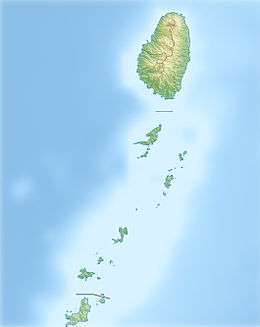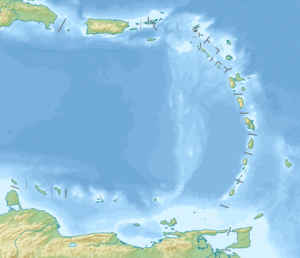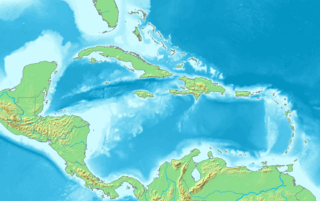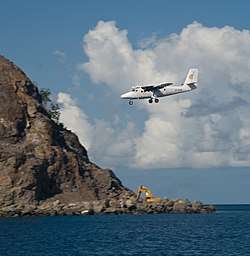Canouan
Canouan (pronounced "can - ah - wan") is an island in the Grenadines belonging to Saint Vincent and the Grenadines. It is a small island, measuring only 3.5 miles (5.6 km) by 1.25 miles (2 km) and has a surface of 7.6 km². It lies approximately 25 miles (40 km) south of the island of St. Vincent. The population is about 1,700[1].
Location of Canouan | |||||||||
 Canouan  Canouan  Canouan | |||||||||
| Geography | |||||||||
|---|---|---|---|---|---|---|---|---|---|
| Location | Caribbean Sea | ||||||||
| Coordinates | 12°43′N 61°20′W | ||||||||
| Area | 2.93 sq mi (7.6 km2) | ||||||||
| Administration | |||||||||
| Demographics | |||||||||
| Population | 1700 | ||||||||
| Additional information | |||||||||
| |||||||||
A barrier reef runs along the Atlantic side of the island. The highest point on the island is Mount Royal. Two bays, Glossy and Friendship, are located on the southern side of the island.
History
Some time prior to 200 B.C. a cultivated tribe called the Arawaks reached the island using dug-out canoes. These new residents brought plants, animals, and basic farming and fishing skills with them. They lived there for 1,500 years until the Caribs invaded the island.
More than 200 years after Columbus laid eyes on St. Vincent, the Europeans established a kind of permanent settlement. Its mountainous and heavily forested geography allowed the Caribs to defend against European settlement here longer than on almost any other island in the Caribbean.
After the Caribs were defeated on other islands they joined slaves who had escaped repression on Barbados by following the current and trade winds westward to St. Vincent, as well as those who had survived shipwrecks near St. Vincent and Bequia.
The mixed descendants of the island warriors and the freed Africans, who became known as the Black Caribs, had a common distrust and disgust for the Europeans, and proved to be a fearsome foe. The Caribs feared complete domination so they allowed the French to construct a settlement on the island in 1719. The French brought slaves to work their plantations. By 1748, the Treaty of Aix-la-Chapelle officially declared St. Vincent and its surrounding islands to be a neutral island, controlled by neither Britain nor France. The two countries continued to contest control of the islands, however, until they were definitively ceded to the British in 1814.
In 1951 universal adult suffrage was introduced in Saint Vincent and the Grenadines[2] and in 1979, it became an independent state within the British Commonwealth[3] with a democratic government based on the British system.
Climate
The average daytime temperatures range from 24 to 30 °C (75 to 86 °F). The driest season is from December to May. The coolest months are between November and February.[4]
Resort development
In the early 1990s the Canouan Resorts Development Ltd (CRD) company was formed and secured lease for areas of the island to build 2 hotels - the former Raffles Resort site and Tamarind Beach Hotel site. At this point the building arm of CRD Ltd. Built roads throughout Canouan (previously only dirt tracks), installed electricity to the island and residents houses and provided desalinated water for the first time. Prior to that, fresh water was brought by boat from St. Vincent on a regular basis. Locals not employed by the resort were forbidden admittance to the property as it was private property, although the beaches remained open for public use. It was announced that the resort would revert from Raffles/Fairmont Resorts back to Carenage Bay Resort on May 20, 2010.[5] The Raffles property was torn down afterwards and a new resort was opened in 2016, which since 2018 has been managed by Mandarin Oriental.[6]
Education
There are 2 schools on Canouan - the Government Primary school and the independent Pelican School which is an accredited Cambridge International School. There is also an official Canouan Pre-school located close to the primary school.
Transport

In 2008, the runway at Canouan Airport was lengthened to almost 6,000 feet to accommodate larger aircraft. It is now the jet port for the Grenadines.
Scheduled ferries link Canouan to St. Vincent, Union Island and Mayreau.[7]
Notable people
NBA player and political activist Adonal Foyle hails from Canouan, and former Prime Minister of St. Lucia Sir John Compton was born there.
Footnotes
- "St Vincent and the Grenadines, Population and Housing Census Preliminary Report 2012". The Census Office, SVG Government. Retrieved 31 December 2015.
- Gonsalves (1994), p. 74.
- "Archived copy". Archived from the original on 2015-10-11. Retrieved 2012-01-10.CS1 maint: archived copy as title (link)
- http://www.canouanisland.com/canouanislandinformation.html
- http://www.travelagentcentral.com/beach-resorts/canouan-island-resort-change-management-21159
- "You May Not Know This Caribbean Island But You Should". Forbes. March 30, 2018. Retrieved May 20, 2020.
- "Canouan, Mayreau & Union Island Ferry Schedule". SVG Tourism Authority.
References
- Gonsalves, Ralph E. History and the Future: A Caribbean Perspective. Quik-Print, Kingstown, St. Vincent, January 1994.
- Berkmoes, Ryan, Ver and Raub, Kevin (2011). Caribbean Islands, 6th Edition. Lonely Planet. ISBN 978-1-74179-454-0.